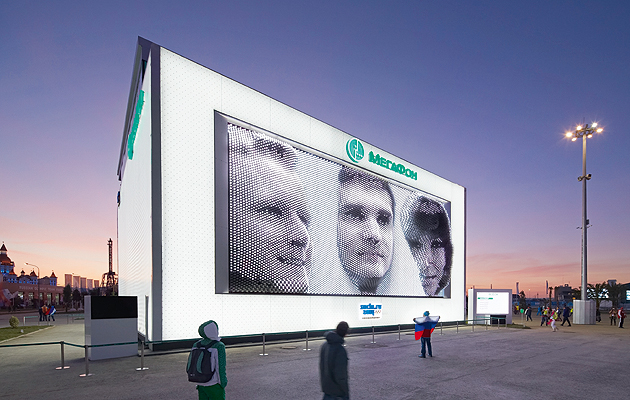|
Each of the 11,000 pins could extrude up to 2m (Image: © Hufton+Crow) |
||
|
Asif Khan’s installation for the Winter Olympics was a screen of motorised pins that created monumental reliefs from scans of visitors’ faces Visitors to the Winter Olympic Games at Sochi were greeted by a huge screen on which a triptych of portraits was displayed. They could queue up to have their own faces 3D scanned in a photo booth. At an assigned time these would be projected on to the facade, a grid of motorised pins that formed a 3D relief resembling an outsize Pin Art executive toy. “It’s like Mount Rushmore,” says architect Asif Khan, “but instead of presidents, it’s you and me. You become a monument in your own right.” Khan was responsible for the similarly interactive Coca Cola Beatbox in London’s Olympic Park, a pavilion made of interlocking sound cushions that visitors could play like a musical instrument. Khan’s collaborator on both projects was Basel-based engineer iart. Scott Eaton, a specialist in digital anatomy who collaborates with Pixar, created software that arranged these faces so they were as iconic and easily recognisable as possible. The building was a simple steel-framed cube, essentially a huge light box. (Khan shows me images of it seen glowing from space.) The screen, which Khan compares to a narrative frieze on a classical building, is composed of 11,000 pins or “actuators”. Each pixel can extrude up to 2m and contains an LED light at the spherical tip that allows for vibrant, colourful displays. It was initially planned to have these pins cover all four facades of the building and push through a lycra skin. Visitors could watch the display from an amphitheatre that Khan landscaped into the grounds, and a podium – which referenced the games – was situated in the optimal position for selfies. The sponsor was Russian telecoms company MegaFon. Unlike the Coca-Cola Beatbox, which notably featured no logo, the Sochi pavilion is branded with the company’s Cyrillic script, exacerbating the billboard effect. (Khan has had calls from numerous advertisers.) With a nod to his sponsor, Kahn explains that the building was intended to be “about communication, the most basic form of which is our faces”. He hoped that the hundreds of thousands of people who appeared on the facade would “invest it with emotion”. Khan hopes that the pavilion will have an afterlife in Moscow’s Gorky Park, where he is in talks to build a temporary gallery space for a large museum. He is also poised to build two other pavilions: one for Melbourne’s Light in Winter Festival and another shortlisted for next year’s Milan Expo. “They’re a medium in which you can try out things at the cutting-edge,” Khan says. “We’re using them as test beds of ideas that might be transferred to permanent buildings which, as young architects, you don’t get to make very often.” |
Words Christopher Turner |
|
|
||

















